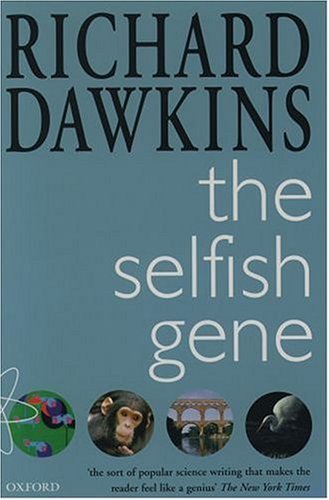 The Selfish Gene Richard Dawkins |
On first read, Richard Dawkin’s The Selfish Gene seems repetitive. Dawkins continually takes asides to remind the audience that his verbage, words like “compete,” “betray,” “steal,” etc, in describing animal behaviors are not meant to imply altruism or malevolence, but describe a behavior’s effect on a gene’s ability to propigate. Through chapter after chapter he exhaustively explores different situations in various scopes and the evolutionary dynamics at work within them.
Dawkins’ borderline excessive treatment of his subject is purposeful. For he is attempting to teach his readers how to think in evolutionary terms. He works, quite successfully, to change how we view the world around us, to see all existence from an evolutionary standpoint.
The opening chapter of Dawkins’ book explores evolution before the first single-celled organisms emerged. This is a time when molecules compete for atoms, with stronger molecules surviving to aquire more atoms. Eventually, a self-replicating molecule emerges, similar to the double-helix chains that comprise DNA.
When we get into animal behaviors, Dawkins frames everything in terms of energy. This is a fascinating way to look at the world. Stripping away all the extraneous information, all the social influences on why we do things, and seeing our world purely in terms of solar energy being consumed by plants in turn consumed my animals which are consumed by other animals, we can easily see the importance of aquiring energy, but we often overlook the importance of conserving energy as well.
So many behaviors in the animal kingdom are meant to conserve one animal’s energy by getting another animal to expend energy. The starkest example of this behavior is the cukoo, which lays its egg in the nest of another bird species. When the cukoo hatches early, it pushes the other eggs out of the nest and survives off of the care of its adopted mother. Thus, the cukoo mother tricks another species into raising its offspring, freeing it to expend her energy into producing more offspring.
Similar relationships exist within species, and Dawkins spends a great deal of time exploring the different strategies infants may employ to consume as much of their mother’s energy as possible at the expense of their siblings. Relations between the sexes are also explained in terms of energy, with the male strategy of exploiting the female with sperm, which can impregnate many females, and the female evolving better eggs and fetal environments to entice males into staying to help provide for their offspring. There are even different strategies for males and females, with some males loyal and others deserters, while some females may demand more from males during the courtship phase as a test of loyalty or deserted females may try and trick another male into thinking the offspring is theirs.
There are innumerable strategies at work in the complex web of evolution, and Dawkins explores many of them with simplistic yet engaging detail. All of these strategies and biological innovations have one purpose: to propogate innanimate DNA sequences. Everything plants, animals, and humans do is to carry these combinations of molecules into the future. How successful these biological and behavioral strategies are has less to do with us than with the molecules themselves, which define almost everything we do.
Almost because Dawkins introduces a concept that has become a staple in our Information Age lexicon: the meme. Mammals, especially humans, are not born into this world pre-programmed with everything they need to know to survive. There is an extended childhood, where we learn from our parents how to interact with our environment. Not quite a tabula rosa or blank slate, but born with our heads empty enough that we can learn how to behave wherever we are born to maximally take advantage of that environment. The highly adaptive cerebral cortex, more than anything else, has allowed human beings to inhabit and adapt to every corner of the Earth.
As a result, evolving memes, not genes, have become our primary method of adaptation. Humans with good ideas will survive and the bad ones will quickly die out of the memepool. Examples of such bad ideas are winners of the (often ficticious) Darwin Awards. While examples of the good ideas surround our everday life in the form of technological, medical, and educational advances. As Janine Benyus wrote, “After 3.8 billion years of research and development, failures are fossils, and what surrounds us is the secret to survival.”
The strength of Dawkins’ analysis of various evolutionary aspects is so convincing because of his ability to quantify seemingly unquantifiable variables. With simple mathematics he is able to establish the degree to which intra-species cooperation benefits its members. Dawkins uses game theory to evolution, specifically the “Prisoner’s Dilema,” to explain altruism in his now famous Nice Guys Finish First argument.
Dawkins was criticized early on for The Selfish Gene because many saw it as a possible defense for eugenics and rejected what they thought was a cold and inhumane representation of nature, but today it is widely accepted as one of the more important texts in modern thinking in existence. Dawkins’ thorough vision of a world completely defined in terms of evolution, deconstructed to just its basic elements of genes and energy will change its reader’s way of looking at the world, and in this sense, it is a very powerful collection of memes that will prove even more successful as human understanding catches up to it.